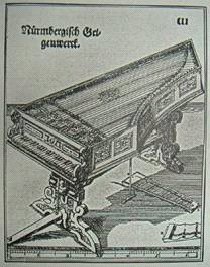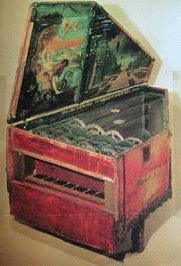Rubbing cat belly with horsehair
Keyboard instrument can be classified into several groups. First group is represented by piano, celesta and carillon which adapt a sound generation principle of hitting the sound source by hammers. In a harpsichord and a virginal, quill is used to pluck the strings. Clavichord strings are pushed by metal tangents and organ pipes are blown by air pressure. In playing any of these instruments, musical expression is concentrated in the moment of first break. In the piano or harpsichord, sound simply decays after the first break. Organ players can sustain the sound as long as the key is kept being pressed. However, no musical expressions can be made after the sound is released. In contrary, the Geigenwerk has a potential to modify the sound in its dynamics and pitch after the string starts vibration.
 Between 1488 and 1489, Leonardo da Vinci had drawn a number of sketches
for musical instruments with a keyboard and mechanically driven bows. Leonardo called these instruments as
viola-organista. Three different
types of bow driving mechanisms are described, such as a rotating circular
wheel, an endlessly running belt and a reciprocally moving bow. Although sketches were found, there is
no evidence of existence of actual instruments of any types of above mentioned
mechanically driven bows in the period of Leonardo's life. After about 100 years, 1575, Hans Hyden
of Nuremberg made a circular wheel type instrument, but this instrument is not preserved
and only an illustration can be seen in a book, Syntagma musicum by Michael
Praetorius. Only one existing
historically made this type of instrument is the one made by Fray Raymundo Truchado, a Spanish monk in 1625. This
instrument is preserved at the Mahillon
collection of the Musée Instrumental in Brussels.
Between 1488 and 1489, Leonardo da Vinci had drawn a number of sketches
for musical instruments with a keyboard and mechanically driven bows. Leonardo called these instruments as
viola-organista. Three different
types of bow driving mechanisms are described, such as a rotating circular
wheel, an endlessly running belt and a reciprocally moving bow. Although sketches were found, there is
no evidence of existence of actual instruments of any types of above mentioned
mechanically driven bows in the period of Leonardo's life. After about 100 years, 1575, Hans Hyden
of Nuremberg made a circular wheel type instrument, but this instrument is not preserved
and only an illustration can be seen in a book, Syntagma musicum by Michael
Praetorius. Only one existing
historically made this type of instrument is the one made by Fray Raymundo Truchado, a Spanish monk in 1625. This
instrument is preserved at the Mahillon
collection of the Musée Instrumental in Brussels.
 Two questions came across to me: 1. why this instrument is not used
today? 2. would it be at all possible to make a keyboard instrument which can produce
dynamic expressions and adjusting tone pitch with sustaining tones? To me, making the instrument by myself
was the only possible way to try to find the answers to these questions. I have visited Brussels and closely examined the Truchado’s
instrument. The instrument was not
in a good condition and I could hardly image the original quality of sound and
workmanship. Design of my first
instrument was not based on historical works. However, as seen in the Truchado’s instrument, I used parchment on the friction
wheels. This material is also used
in the friction wheel of hurdy-gurdy.
After assembling the instrument, I was very much excited to make the
first note. However, the result was
disappointing. Strings are slipped
on the friction wheel and did not respond quickly to the keyboard action. I realized that the strings were made
with modern technology and the surface finish was extremely smooth, thus no or
minimal friction was applied between the friction wheel and the strings. In one of the Japanese plucking
instrument, Shamisen, about 20 micron thin cat skin
is used to protect the surface of resonance box, which is also made with cat
skin, from having scratch with the
plectrum. I cut this thin cat skin
in small pieces and glued on the strings where the friction wheel comes in
contact. It significantly improved
the sharp start-up of the sound.
However, some tones were still slippery. Then, I have replaced the
parchment with horsehair and it helped a quantum changes in consistent start-up
of sound.
Two questions came across to me: 1. why this instrument is not used
today? 2. would it be at all possible to make a keyboard instrument which can produce
dynamic expressions and adjusting tone pitch with sustaining tones? To me, making the instrument by myself
was the only possible way to try to find the answers to these questions. I have visited Brussels and closely examined the Truchado’s
instrument. The instrument was not
in a good condition and I could hardly image the original quality of sound and
workmanship. Design of my first
instrument was not based on historical works. However, as seen in the Truchado’s instrument, I used parchment on the friction
wheels. This material is also used
in the friction wheel of hurdy-gurdy.
After assembling the instrument, I was very much excited to make the
first note. However, the result was
disappointing. Strings are slipped
on the friction wheel and did not respond quickly to the keyboard action. I realized that the strings were made
with modern technology and the surface finish was extremely smooth, thus no or
minimal friction was applied between the friction wheel and the strings. In one of the Japanese plucking
instrument, Shamisen, about 20 micron thin cat skin
is used to protect the surface of resonance box, which is also made with cat
skin, from having scratch with the
plectrum. I cut this thin cat skin
in small pieces and glued on the strings where the friction wheel comes in
contact. It significantly improved
the sharp start-up of the sound.
However, some tones were still slippery. Then, I have replaced the
parchment with horsehair and it helped a quantum changes in consistent start-up
of sound.
 However, in general, this instrument was not player-friendly, at all. Driving the friction wheel with a
treadle can give enough trouble for the player to concentrate in music, yet
finger tips are required extremely sensitive touch to produce proper quality of
sound. While performing a series of
experiments to improve the instrument, a professional keyboard player,
specialized in Renaissance and baroque music, came to my atelier and started playing the prototype
instrument. After about an hour, he
started producing real quality sound of music from that instrument. I was inspired with his playing and was
very much encouraged to design a new instrument. The instrument in this exhibition was
designed with all positive experimental results carried out on the first
instrument, which was used as a test platform.
However, in general, this instrument was not player-friendly, at all. Driving the friction wheel with a
treadle can give enough trouble for the player to concentrate in music, yet
finger tips are required extremely sensitive touch to produce proper quality of
sound. While performing a series of
experiments to improve the instrument, a professional keyboard player,
specialized in Renaissance and baroque music, came to my atelier and started playing the prototype
instrument. After about an hour, he
started producing real quality sound of music from that instrument. I was inspired with his playing and was
very much encouraged to design a new instrument. The instrument in this exhibition was
designed with all positive experimental results carried out on the first
instrument, which was used as a test platform.
I have already started designing the next instrument, expecting to make it as the definitive design.
Akio Obuchi
February 2, 2003